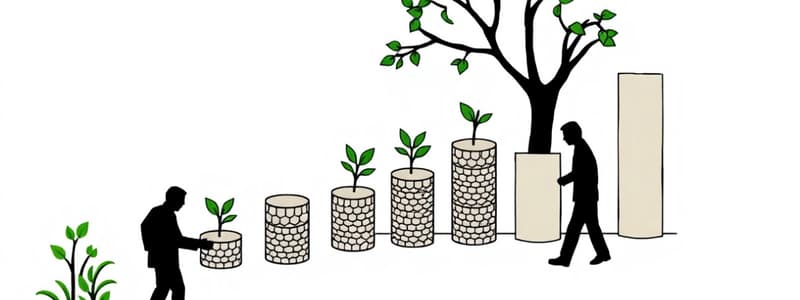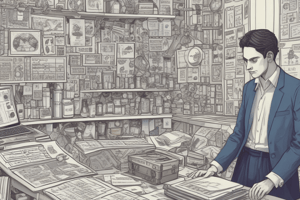Podcast
Questions and Answers
What is the definition of economics?
What is the definition of economics?
Economics is a social science that studies the efficient allocation of scarce resources to maximize the fulfillment of unlimited human needs and wants.
What are the two main branches of economics?
What are the two main branches of economics?
- Supply and Demand
- Consumer and Producer Economics
- International and Domestic Economics
- Microeconomics and Macroeconomics (correct)
What are the three basic questions every economy must answer?
What are the three basic questions every economy must answer?
- What to import, what to export, and what to trade
- What to produce, how to produce, and for whom to produce (correct)
- How to allocate resources, how to create jobs, and how to balance the budget
- How to save, how to invest, and how to spend
Scarcity refers to a situation where people are unable to obtain the amount they want at the prevailing price.
Scarcity refers to a situation where people are unable to obtain the amount they want at the prevailing price.
What is opportunity cost?
What is opportunity cost?
What are the four categories of economic resources?
What are the four categories of economic resources?
What is the main purpose of the Production Possibilities Frontier (PPF)?
What is the main purpose of the Production Possibilities Frontier (PPF)?
A capital-intensive technique uses more capital than labor in its production process.
A capital-intensive technique uses more capital than labor in its production process.
What are the three main decision-making units in a closed economy?
What are the three main decision-making units in a closed economy?
What is the key difference between a two-sector and a three-sector circular flow model of the economy?
What is the key difference between a two-sector and a three-sector circular flow model of the economy?
Flashcards
Economics definition
Economics definition
Economics is the social science that studies the efficient allocation of scarce resources to maximize fulfillment of unlimited human needs and wants.
Scarcity
Scarcity
The fundamental economic problem of having unlimited wants but limited resources.
Microeconomics
Microeconomics
The branch of economics that analyzes the behavior of individual decision-making units like households, firms, and markets.
Macroeconomics
Macroeconomics
Signup and view all the flashcards
Positive economics
Positive economics
Signup and view all the flashcards
Normative economics
Normative economics
Signup and view all the flashcards
Inductive reasoning
Inductive reasoning
Signup and view all the flashcards
Deductive reasoning
Deductive reasoning
Signup and view all the flashcards
Economic growth
Economic growth
Signup and view all the flashcards
Saving rate
Saving rate
Signup and view all the flashcards
Economic resources
Economic resources
Signup and view all the flashcards
Development economics
Development economics
Signup and view all the flashcards
Industrial economics
Industrial economics
Signup and view all the flashcards
Transport economics
Transport economics
Signup and view all the flashcards
Environmental economics
Environmental economics
Signup and view all the flashcards
Allocation of resources
Allocation of resources
Signup and view all the flashcards
Consumer behavior
Consumer behavior
Signup and view all the flashcards
Production theory
Production theory
Signup and view all the flashcards
Theory of demand and supply
Theory of demand and supply
Signup and view all the flashcards
Market structure
Market structure
Signup and view all the flashcards
Fundamental Concepts
Fundamental Concepts
Signup and view all the flashcards
Human wants
Human wants
Signup and view all the flashcards
Economic problem of scarcity
Economic problem of scarcity
Signup and view all the flashcards
Study Notes
Introduction to Economics
- The course covers six chapters
- Chapter 1: Basics of Economics
- Chapter 2: Theory of demand and supply
- Chapter 3: Theory of consumer behavior
- Chapter 4: Theory of production and cost
- Chapter 5: Market structure
- Chapter 6: Fundamental concepts of macroeconomics
Chapter 1: Basics of Economics
- Definition: Economics is a social science that examines the efficient allocation of scarce resources to satisfy unlimited human needs/wants.
- Key Facts:
- Economics studies scarce resources
- It studies the efficient allocation of resources
- Unlimited human wants exist with limited resources, creating scarcity
- Rationales of Economics: The reason for studying economics is the existence of unlimited human wants and limited resources to satisfy them.
Scope and Methods of Analysis
- Scope: Economics covers various issues with many specializations, including development, industrial, transport, and environmental economics.
- Methods: There are different ways to analyze economics. Positive economics analyzes facts and answers "what was?", "what is?", and "what will be?" questions, while normative economics deals with opinions and cannot be proven or rejected with facts.
Reasoning Approaches in Economics
- Inductive Reasoning: A method of reaching correct general statements or theories based on specific facts. It involves developing or deriving theories from empirical observations.
- Deductive Reasoning: A method of arriving at particular or specific correct statements from general statements (or theories). It involves testing theory validity by moving from general principles to specific cases.
Economic Growth and the PPF
- Economic Growth: Occurs when the total output level increases due to an increase in resources' quantity and/or quality or improvements in technology.
Basic Economic Questions
- What to Produce?: The allocation of resources, deciding which goods and in what quantities to produce.
- How to Produce?: Choosing the production technique – labor-intensive or capital-intensive.
- For Whom to Produce?: The distribution of the national product, answering who receives the output.
Economic Systems
- Economic System: A set of organizational and institutional arrangements to address basic economic questions.
- Types:
- Capitalist: Characterized by private ownership of resources, minimal government intervention (free market/laissez-faire), freedom of choice, profit motive, and competition. Shortcomings include inequality and negative externalities.
- Command: A system where the state owns and controls production and distribution. Features include collective ownership and central planning. Shortcomings can include lack of efficiency and limited innovation.
- Mixed: Combines elements of both capitalist and command systems, with both public and private sectors co-existing. Features include co-existence of public and private sectors, economic welfare, economic planning, price mechanism, and economic equality.
Decision-Making Units and Circular Flow Model
- Decision-Making Units:
- Households: Make decisions on resource use and product demand.
- Firms: Produce and sell products, deciding on resource use and output.
- Government: Influences markets, provides public goods and services.
- Circular Flow Model: A visual representation showing the flow of resources, goods/services, and money throughout the economy among the decision-making units and within the product and factor markets.
Scarcity, Choice, and Opportunity Cost
- Scarcity: The fundamental economic problem where resources are limited in supply to meet unlimited human needs and wants.
- Opportunity Cost: The value of the next best alternative that is sacrificed to obtain something.
- Resources: Resources are categorized as "free" (easily available at zero cost) and "scarce" (limited in supply, requiring trade-offs). Scarce resources include labor, land, capital, and entrepreneurship.
- Production Possibility Frontier (PPF): A curve that shows the various possible combinations of goods and services an economy can produce given its resources and technology. Producing on the PPF line is efficient.
Reasoning Approaches in Economics -- Inductive
- A method for reaching general theories based on specific facts, typically by analyzing numerous cases within a group.
Reasoning Approaches in Economics -- Deductive
- A method of moving from general statements (theory) to specific conclusions (predictions), typically testing the validity of the theory.
Law of Increasing Opportunity Cost
- The cost per additional unit of output increases as more of a particular good is produced. This is due to the fact that resources are not perfectly adaptable to different uses, and specialization effects reduce an economy's specialization toward different production uses..
Example of Opportunity Cost Calculation
- Using a table and graph showing alternative production possibilities, calculation of the opportunity cost (in the form of lost output of one good per additional unit of another good) can be illustrated when an economy moves between different production points on the production possibility frontier.
Studying That Suits You
Use AI to generate personalized quizzes and flashcards to suit your learning preferences.




